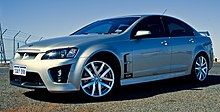
The HSV E Series is a high-performance car based on the Holden VE Commodore produced by the Australian carmaker Holden under its HSV marque. Released in 2006, the E Series range included Clubsport, Maloo, Senator and GTS models. It featured distinct styling elements like LED taillights and vertical front fender grilles. Initially powered by a 6.0L LS2 V8 engine, it transitioned to a 6.2L LS3 V8 in 2008, offering up to 325 kW (442 PS; 436 hp) in the E Series 2 version.
The E Series 2, released in 2010, introduced a facelift with new bumpers, a twin-nostril bonnet, and updated engines, along with improved fuel economy, launch control, and competition mode ESC. The E Series 3, starting in 2011, added options like LPG compatibility, new driver interfaces, and various interior updates.
The Clubsport also had variants like the R8 Tourer (wagon), exported versions (CSV CR8 for the Middle East), and high-performance models like the Vauxhall VXR8 in the UK, which received a supercharged version. The HSV range included more powerful models such as the GTS, Maloo (utility), and Senator (luxury sedan), each with unique performance and design features. The W427, a limited edition model, featured a 7.0L LS7 V8 and was the most powerful vehicle in the E Series lineup.
Versions
Clubsport
The E Series Clubsport R8 takes its fundamental body structure from the mainstream VE Commodore. It is also the standard model in the HSV line-up. With the deletion of lower lines of V8 HSV models the Clubsport slipped down to the entry level HSV V8, on a par with the Manta of the VR-VS-VT series. As such the sales of E Series Clubsports has been over shadowed by the sales of the E Series GTS.

The Original E-Series Clubsport was released in September 2006. The Clubsport had LED taillights and vertical front fender grilles only found on HSV E-Series models. Cloth trim was standard on Clubsport models with leather being an option.
In September 2008, the Clubsport R8 Tourer was released. The Tourer is a wagon version of the R8, based on the Sportwagon. The two Clubsport models were powered by the 307 kW (417 PS; 412 hp) LS2 6.0 L V8 and Tremec T56 six-speed manual gearbox, capable of doing 0–100 km/h (0–62 mph) in 5.8 seconds with the manual gearbox and 5.9 seconds when fitted with the auto transmission and having a top speed of 160 mph (257 km/h). From April 2008, all HSV models use 6.2 L LS3 V8s, instead of the previous LS2. The LS3 powers the HSVs at 317 kW (431 PS; 425 hp) and 550 N⋅m (406 lb⋅ft).

The HSV E Series 2 range was released 2010 and was the most major update since the release of E Series HSVs. Prices on the E2 Clubsport models started at $65,990 for the Clubsport R8 and $66,990 for the Clubsport R8 Tourer. The range received many cosmetic changes with new front and rear bumpers, twin-nostriled bonnet (from the Pontiac G8) and a new range of wheel designs. The Series 2 has a very distinctive looking set of daytime running lights standard across the E2 range. The new engines is the range are the 325 kW (442 PS; 436 hp) 6.2 L LS3 V8 used exclusively by the HSV GTS, with the rest of the E2 range being powered by an LS3 in 317 kW (431 PS; 425 hp) trim. The new engines have also improved fuel economy by 4.2% on the LS3 V8. New is the intelligent launch controls, competition mode ESC and extended cruise control systems which are all standard for E2 models excluding intelligent launch control which is only available with a manual transmission.


HSV E Series 3 or E3 commenced sales in 2011. Model changes for the E series 3 include an option for LPI system (for an extra $5990) allowing the vehicle to run on LPG and unleaded petrol; the LPI system is not available on the ClubSport R8 Tourer. Cosmetic changes include a new spoiler and revised exhaust tips. HSV E Series 3 models reach 0–100 km/h (0–62 mph) in 5.8 seconds. The HSV E Series 3 introduced the new HSV Enhanced Driver Interface; it has the same interface as the Holden IQ (found in VE Series II Commodores) but with added function. The system allows users to access the car's computer and monitor fuel consumption, stability, g-force and vehicle dynamics. Other functions include data logging options, digital gauge displays, stopwatch, driver and racing options, along with controls for the Grange's Bi-Modal exhaust and Side Blind-Zone Alert. The HSV Enhanced Driver Interface and satellite navigation is standard across the E series 3 range.
Vauxhall VXR8
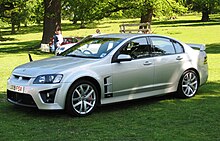

Problems playing this file? See media help.
350 Vauxhall VXR8s per year were scheduled for official importation into the UK, at a price of £35,105. The LS3 V8 is particularly popular among tuners in the US, so performance parts are widely available. A supercharger kit was available, which increased the power output to 395 kW (537 PS; 530 hp). The supercharged Bathurst edition VXR8 was reviewed on Top Gear, and its power-lap time was 1 min 26.3 seconds, a similar time to the old BMW M5 E60.
In July 2010, Autocar reported that, "VXR8 was quietly dropped from the price lists several months ago" after stocks ran out. However, a facelifted version based on the new HSV E3 GTS was released to the UK market in April 2011 at a price of around £49,500, almost £15,000 more than the previous VXR8, but significantly cheaper than most of its rivals, like the Mercedes E63 AMG and BMW M5. Vauxhall has offered the 2011 Clubsport to UK customers as a special order model.
CSV CR8
In 2007, the same model was exported to the Middle East badged as the CSV CR8, albeit in left hand drive. In this instance, CSV stands for "Chevrolet Special Vehicles", not to be confused with the unrelated, but also Holden Commodore-based Corsa Specialised Vehicles (CSV) cars.
GTS
The fundamental underpinnings are based on the mainstream VE Commodore models of the same years. The car is powered by GM's 6.2-litre LS3 V8 engine, with a maximum power output of 442 PS (325 kW). Buyers have the option of a six-speed manual transmission or six-speed automatic transmission; the manual is capable of reaching 0–100 km/h (0–62 mph) in 5.5 seconds and the automatic is capable of 0–100 km/h (0–62 mph) in 5.6 seconds.
- E Series 1
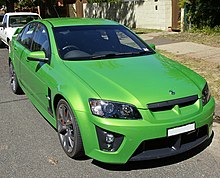

The GTS has usually used a more powerful engine and robust drivetrain than other HSV models, however the E-Series 1 GTS shared the 6.0L LS2 V8 engine with 412 bhp (307 kW) of power and 405 lb⋅ft (549 N⋅m) of torque, with the cheaper Clubsport and the luxury Senator. The major difference between the E-Series GTS and other HSV models in the range is the Magnetic Ride Control (MRC, or "MagneRide"). MRC utilises magnetorheological dampers to improve the car's handling and dynamics. In the GTS, the MRC can be switched between Performance and Track response modes at the touch of a button. MRC is not available on the Clubsport; it is standard equipment of the Senator, but switches between "Luxury" and "Performance", there is no "Track" mode like the GTS has.
HSV claims the braking performance of the GTS is better than some of the world's leading sports cars, including the BMW M5, Mercedes-Benz AMG CLS55 and Lamborghini Gallardo. The GTS can stop from 100 km/h (62 mph) in just 36 metres, only 30 centimetres shy of a Porsche 997.
- E Series 2


Released in September 2009, the E Series 2 HSV GTS incorporated a more powerful motor and drivetrain than other HSV models. It retains the same GM LS3 6.2L V8 engine but while the rest of the HSV range still have 317 kW or 425 bhp, the GTS engine is rated at (325 kW). Twin bonnet scoops have returned to this model from the styling of the Pontiac G8. Other changes include the availability of launch control on manual versions, a recalibrated version of the magnetic ride control suspension with stiffer springs for the HSV GTS, wider wheels and a new high-flow dual-mode muffler system that produces a throatier roar under heavy acceleration. The E-Series 2 stability control system also has a Competition setting which allows for more wheel slip for special track or motorsport applications. The cruise control brakes the car when it is travelling downhill to ensure its speed stays within one per cent of the set speed. This model has daytime running lights.
- E Series 3


The E Series 3 was announced in September 2010. It carried the same motor and drivetrain as before, and only minor changes to the exterior. In this series HSV focused on changes to the interior of the car as well as major upgrades to the computer systems and a new electronic interface called the HSV Enhanced Driver Interface. External changes included the shock wave exhaust tips and grilles and new HID Xenon adaptive projector headlamps. The control panel changes included a new 'Oracle Dash' with upgraded trip computer, tire pressure monitors and fuel statistics; the centre console was reworked, introducing the Holden touchscreen IQ system and the HSV EDI performance data logging system (similar to the Nissan GT-R), which displays real-time information on engine speed, brakes, gear shifts, g-forces on the car, steering angle, fuel economy, stability control, Magnetic Ride Control suspension, car dynamics, Bi-Modal Exhaust, battery voltage, oil pressure, power, torque, elevation, exhaust pressure, intake manifold pressure and air intake temp. The system includes preloaded race track locations, stop watches and track maps, satellite navigation, digital radio, Bluetooth, optional DVD player and ability to download data onto a PC using the Motech i2 software. The E Series 3 introduced (SBZA) Side Blind Zone Alert which uses ultrasonic sensors to alert drivers of traffic obstructions in blind spots. Using the HSV EDI the driver can customize operation of the car by for example turning off stability control and controlling the Bi-Modal Exhaust. The E Series 3 offered the option of HSV LPI (Liquid Propane Injection), an LPG Autogas system which allows the use of liquid propane as an alternative fuel. The LPI is controlled by the car's ECU and seamlessly changes from petrol to LPG when the engine has reached optimum temperature (when maximum engine power is required, the system automatically switches back to petrol).
Maloo
The all-new E Series Maloo utility was a late arrival, released in October 2007, and only available as the Maloo R8. The Chevrolet Corvette-based 6-litre LS2 V8 was now tuned to deliver 307 kW (412 hp) and 550 N⋅m (410 lb⋅ft). Later 2008 and onwards models saw the power output rise to 317 kW (425 hp) with the adoption of a 6.2-litre LS3 V8 engine. Refinements on the E Series include Electronic Stability Control, five-star ANCAP rating, and linear control suspension.
In August 2009, the facelifted E Series 2 was released which uses the same drivetrain as the W427 with an upgraded dual plate clutch not found on previous models. Late in the model run, HSV released the limited edition GXP sedan and Maloo GXP ute, being amalgams of HSV and Pontiac G8/ST components.
A mildly cosmetically altered E Series 3 was released in September 2010, and with it a special 20 years of Maloo edition limited to just 100 examples, featuring unique exterior equipment, including matte black 'Vector E' vents on the front guards and bonnet, 20-inch GTS alloy wheels, bi-modal exhaust system, Side Blind Zone Alert (SBZA), and new hero colours, including 'Hazard' yellow. The interior of the 20th anniversary Maloo features special leather upholstery, satellite navigation, Enhanced Driver Interface (EDI), and a specific rear window decal and numbered build plate.
-
 HSV Maloo (E Series)
HSV Maloo (E Series)
-
 HSV Maloo (E-Series)
HSV Maloo (E-Series)
-
 HSV Maloo (E-Series 2)
HSV Maloo (E-Series 2)
-
 HSV Maloo (E-Series 2)
HSV Maloo (E-Series 2)
-
 HSV Maloo (E-Series 3)
HSV Maloo (E-Series 3)
-
 HSV Maloo (E-Series 3)
HSV Maloo (E-Series 3)
Senator
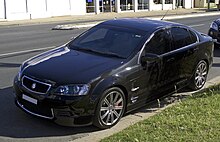




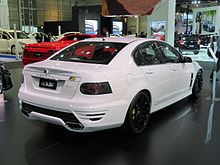
The E Series Senator Signature is based on the VE Commodore and was released in August 2006 with 307 kW (412 hp) of power. It is a four-door, 5 seat sedan, is rated to tow a maximum of 1,600 kg (3,527 lb) and is fitted with automatic transmission and leather interior as standard. The development cost for the E Series Senator was more than the VT, VX, Y Series and the Z Series Senators combined. In general, the HSV Senator Signature is a significantly more upmarket form of the Holden Calais-V, with a matching pricetag.
The E Series Senator is 4,943 mm (194.6 in) long and 1,899 mm (74.8 in) wide, and the stopping distance from 100 km/h (62 mph) is about 36 metres. The Senator is equipped with 19-inch, 10-spoke chrome shadow alloy wheels. The cabin features carbon fibre and imitation metal highlights. For the first time there are no visible wood grain trims that have featured in previous models. The rear lights on the Senator are full LED and were repositioned, lowering them by 120 mm (4.7 in) to help differentiate the car from its Holden donor, creating sporting flair yet keeping the luxury image. The development cost to redesign the rear taillights cost HSV $3 million. The designers of the Senator have also attempted to add a more of a luxury feel to the car instead of favouring the aggressive side. The entry level price for the Senator Signature is $76,990, down $4,000 from the previous model.
Like the E-series HSV GTS, the suspension is fitted with switchable Magnetic Ride Control (MRC, or "MagneRide") offering Luxury or Performance modes. It does this by electrically adjusting the viscosity of the ferrofluid inside the shock absorbers, producing different damping levels. Magnetic Ride Control also enhances braking by preventing forward weight transfer when the car is under heavy braking. The MRC system development took three years and cost HSV more than $4.5 million.
Standard gear includes climate control, Blaupunkt sound, cruise control, full trip computer, rear park assist, traction control system, Electronic Stability Control, power mirrors and windows. The oil, voltage and temperature gauges are now digital. The interior offers a choice of light urban beige, white or black for the colours. The carpets remain dark as in the Holden Calais V-Series. The Senator Signature also offers a number of options such as a roof mounted DVD player, front park assist, rain sensing wipers and door entry lamps. Satellite navigation will become available as an option in the near future.
From April 2008, the HSV Senator Signature was fitted with the 6.2-litre Generation 4 alloy LS3 V8 that delivered 317 kW (425 hp) at 6000 rpm and 550 N⋅m (406 lb⋅ft) at 4400 rpm. It can go from 0 to 100 km/h (0 to 62 mph) in around 5 seconds and has a limited top speed of 250 km/h (155 mph). From this MY09 model onwards, the Senator Signature was available with an optional 6-speed manual transmission. In early 2009, HSV introduced a base model Senator at the Melbourne Motor Show. This special model was priced from $69,990 (RRP) with just 30 manual and 59 auto examples produced. While it retained the look of the Signature model, it was essentially a ClubSport with a Senator body kit and did without many of the luxury features mentioned above as well as the MRC suspension, GTS-style seating and shadow chrome finish on the wheels.
In October 2009, HSV released their E2 model upgrades which introduced the "Shockwave" theme to the exterior of the Senator Signature. It was applied in a more subtle way than seen on the ClubSport, GTS and Maloo models with the front end receiving a new grille and some LED daytime running lights while the rear was fitted with the same style of lower body kit as the other sedan models. As with other models in the E2 range, the Senator Signature was available with the "SV Enhanced Options" bi-modal exhaust system and the 20" Pentagon wheel in place of a re-designed 19" wheel. There were no interior styling updates for the E2 model.
2010 saw the arrival of the E3 HSV range which brought with it a raft of interior changes shared with the VE Series II upgrade of HSV's donor vehicle, the Holden Commodore, such as the new Holden iQ audio/infotainment system and safety features such as Side Blind zone alert. It also brought HSV's Enhanced Driver Interface (EDI) system to the Senator, a system that constantly streams real-time vehicle dynamics and performance information to the touch screen in the centre console. The exterior remained mostly unchanged from the E2 model apart from the move to a 20" forged alloy that was available in Dark Stainless or Gloss Black. The LS3 was upgraded to 325 kW (436 hp) with the fitment of the E2 GTS' bi-modal exhaust system. The E3 was also available with the upgraded 6-piston brakes from the GTS and had the option of a modern LPG fuel system called LPI (Liquid Propane Injection) to help reduce the running costs.
Senator SV08


This was a limited edition of 50 vehicles released in late 2008 in the "MY09.5" model year. It was released alongside the limited edition 40 Years GTS. It was primarily to commemorate 20 years since the release of the SV88, one of the first vehicles released by the then new HSV outfit. There were 20 manuals (the first of the general run HSV E Series to use the TR6060 6 speed manual that had only been used in the W427 prior – straight from the current Corvette) and 30 autos. They were released in only 3 colours, Nitrate (silver) Sting (red) & Voodoo (blue). It was also the first VE model Senator to be officially released with a manual. Equipment levels & drivetrain were identical to the Senator Signature of the time. Unique features of the SV08 are: SV08 badging, 20" Pentagon wheels, lower body gloss black accenting (ran along the doors at the same level of the black accenting on the front & rear), chrome mirror head & door handle accents, SV08 sill plates & SV08 build plate.
W427
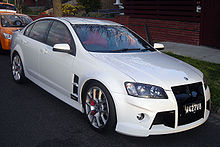

The HSV W427 is the limited edition flagship of the initial E Series range by automobile manufacturer Holden Special Vehicles, released in celebration of the company's 20th anniversary in 2008, but produced until 2009.
The W427 is based on the Holden VE Commodore, but powered by the 7.0-liter LS7 V8. Power outputs are 510 PS (375 kW; 503 bhp) at 7000 rpm and 640 N⋅m (472 lb⋅ft) at 5000 rpm, It features recalibrated Magnetic Ride Control (MRC, or "MagneRide") and stiffer suspension settings than the HSV GTS, as well as a toughened 6-speed manual gearbox, a new exhaust system, larger 6-piston brakes, and strengthened limited-slip differential.
The W427's name is the result of a combination of factors. W is to honour the founder of HSV, Tom Walkinshaw. The 427 is simply the engine capacity in cubic inches, but it is also a nod to the HRT 427C, which won the 2002 and 2003 Bathurst 24 Hour motor races.
Consumer interest for production of the W427 actually began with the still-born HRT 427 Coupe of 2002, based on the Holden Monaro. The original W427 concept car was produced in the same body colour as the very first HSV model, the VL Commodore SS Group A SV.
The production version HSV W427 sedan was announced in August 2008 and retailed for A$155,500 (EUR€90920) without optional equipment. Additional cost options amounted to three items : Electric Glass Sunroof, Satellite Navigation, and Rear Passenger Overhead DVD Player. Production was originally intended as a limited run of 427 cars. However, only 137 cars were built (this number does not include the original concept car), sold only in Australia and New Zealand (only three cars were exported to NZ).
Reportedly, Holden Special Vehicles offered the pre-order of build no. 427 (uniquely painted in "Panorama" silver) to a Cairns Monaro collector, who purchased the 2002 HRT 427 coupe for $920,000 in 2008. The last W427 to be built was made to order in July 2009, being build no. 137 in "Heron" white, sold by Shacks HSV in Fremantle, Western Australia, and personally signed by Tom Walkinshaw.
The HSV W427 will be noted in TWR / HSV history as the only car to which Tom Walkinshaw 'personally' attached his name. It was not the first Holden Commodore-based vehicle to be powered by a 7.0L LS7 V8 engine as that honour went to the more affordable Corsa Specialised Vehicles GTS.
- Total HSV W427 production by colour
| Phantom (metallic black) |
Heron (white) |
Sting (red) |
Nitrate/Switch Blade (metallic silver) |
Evoke (metallic grey) |
others |
|---|---|---|---|---|---|
| 44 | 35 | 29 | 23 | 6 | 3 |
| |||||
References
- Go Auto, First Drive: HSV's Clubsport range.
- HSV ClubSport R8 Tourer: Practical Performance Retrieved from http://www.webwombat.com.au
- The Motor Report, HSV Reveals Full E Series 2 Range.
- "HSV Commodore GTS E2 2011". Autocar. 4 July 2010. Retrieved 2 August 2010.
- The Motor Report, HSV E Series 3 E3 range launched in Australia.
- "Chevrolet Special Vehicles debuts in Middle East with the CR8". Autoblog.
- MacLean, Andrew (25 August 2006). "First drive: HSV's E-Series is all class". GoAuto. John Mellor.
- Blackburn, Richard (9 September 2009). "Wilder look for new HSV range". The Sydney Morning Herald.
- ^ "20th Anniversary Maloo R8 Brochure". HSV.com.au. Archived from the original on 15 December 2010. Retrieved 11 April 2011.
- "HSV GXP".
- ^ Wheels magazine 2006 Collector's Edition VE Commodore: The Full Story
- HSV. "HSV Gen-F / HSV Classics". HSV. Archived from the original on 4 March 2014. Retrieved 6 June 2014.
- HSV. "HSV Gen-F / HSV Classics". HSV. Archived from the original on 4 March 2014. Retrieved 6 June 2014.
- HSV. "HSV Gen-F / HSV Classics". HSV. Archived from the original on 1 March 2014. Retrieved 6 June 2014.
- HSV. "HSV Gen-F / HSV Classics". HSV. Archived from the original on 1 March 2014. Retrieved 6 June 2014.
- "HSV W427". Hsv.com.au. Archived from the original (Flash) on 27 September 2008. Retrieved 25 October 2008.
- Hagon, Toby (29 February 2008). "HSV W427: What's in a name?". countrycars.com.au. Archived from the original on 6 July 2011. Retrieved 25 October 2008.
- "FPV's F6E Alive – HSV's W427 Dead". Australian Muscle Car. No. 44. St. Leonards: Chevron Publishing Group. 2009. p. 12. ISSN 1446-5647.
- "VIP Fan orders W427 | carsguide.com.au". Archived from the original on 26 August 2012. Retrieved 6 June 2014.
- "CSV GTS LS7". Wheels. Motoring.com.au. December 2007. Retrieved 21 June 2015.